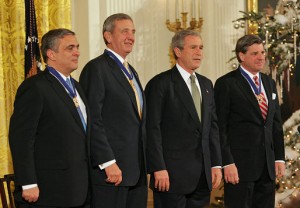The consequences of the 2003 Iraq war have been disastrous – for the US, the Middle East, and most of all, Iraq itself. Surprisingly, even GOP presidential candidates now agree the war was a mistake, even though their standard bearer launched it, albeit with support of many from across the aisle.
It is somewhat less accepted that political appointees spared the American public the ambiguities and doubts in the intelligence reports on Iraq’s WMD program and ties to al Qaeda, all the better to make their case for war. These were less failures of intelligence than manipulations of it.
Other problems that followed the toppling of Saddam Hussein should have been better appreciated and discussed in public. Many were foreseeable.
Disposition of the Shias
The assertion that Iraqis would welcome the invasion was based in part on expectations regarding the oppressed Shia majority, some 60% of the population. Saddam’s regime was built on a Sunni minority, some 18% of the population, which controlled the army, state, and key economic positions, and lorded over the Shias.
Welcoming Saddam’s ouster was not the same as welcoming foreign invasion and occupation, especially a chiefly American one. The US had imposed painful sanctions on the Iraqi people as a whole, not just regime loyalists, and was seen as exceptionally meddlesome in the region. Further, the Shia harbored resentment against the US for encouraging them to rise up during Gulf War One, then sitting back as Saddam’s troops crushed them.
Alarms were raised in Washington when Iranian influence rose in post-Saddam Iraq. This, however, was inevitable. Iran had helped to organize political movements and affiliated militias during the long Iran-Iraq War. IRGC cadres operated inside Iraq long before US troops crossed the berms in March of 2003.
A Shia-based resistance, then, was unavoidable. Resistance was all the fiercer, and better supported from without, owing to Washington’s call for regime change in Iran and the destruction of its nuclear facilities. Iran seemed next, and it responded accordingly with assets in Iraq.
Disposition of the Sunnis
After World War One, the British established neocolonial control over Iraq and enthroned the Sunni Hashemites, who were replaced over the years by other Sunni politicians and officers. The Sunnis saw their preeminence as natural – a view that came to be shared, if reluctantly, by Sunni powers in the region who saw Iraq as a staunch opponent of Shiism and “Persia.”
When unceremoniously unseated by foreign armies with false claims of WMDs and al Qaeda ties, the Sunnis were humiliated and angry. Washington’s demobilization of the Iraqi army worsened matters and provided the manpower, weapons, and leadership for an insurgency.
A better look at Iraq in the decade before the invasion would have revealed the spread of Salafism – an especially austere, militant, and anti-western form of Islam, with ties to Saudi Arabia’s Wahhabists. Salafism had won a following in many military personnel following the debacle against the western coalition in 1991. Defeat led to soul-searching, then to deeper piety, determination, and militancy.
Salafism spread in the Sunni public after 2003 as people sought solace and meaning amid the anomie and turmoil of the insurgency and sectarian mayhem that followed.
International resistance
An invasion of Iraq would of course lead to opposition from the Sunni world. Every American intelligence analyst and case officer knew well of the international opposition to the Russian invasion of Afghanistan in 1979. Many had first-hand experience. US intelligence had observed, funded, and armed foreign fighters who, outraged by Russian aggression, came to fight in Afghanistan.
The CIA and Pentagon prided themselves on orchestrating the international effort. Many in Langley and Alexandria must have known that a redux would follow an invasion of Iraq. The Muslim Brotherhood and Salafi networks were still in existence and hardly well disposed to a US invasion, notwithstanding past assistance against Russia.
The Salafi movement inside Iraq after 1991 was tied into an international network of schools, preachers, and adherents in much of the Middle East. Salafists outside Iraq felt the need to support their brethren; and money and recruits found their way to Iraq.
The older, established Muslim Brotherhood and Salafi networks had an important rival this time – al Qaeda, the network of former mujahideen that banded together to wage war on the West and its vassals in the Middle East.
Fragmentation
US policy in recent years aims to prevent Kurdish and Sunni separatism. This is paradoxical as American policy has brought on disintegration.
After the First Gulf War, the US and allied powers established an aircap over the Kurdish north, preventing Saddam’s army from returning. This created and guaranteed Kurdish autonomy – a term sharing an imprecise boundary with “independence.” With Saddam’s expulsion in 2003 and the ensuing chaos, the Kurds began to push hard against that imprecise boundary.
The Sunnis, concentrated in the north and west, would never accept minority status, though their numbers offer nothing more than that in a representative system. Shias, after decades of Sunni rule, are less than accommodating toward their pitiless former oppressors. Sectarian fighting and a Sunni effort for imprecise autonomy were inevitable, and the effort is underway.
* * *
These dangers, if not in the fuller forms now aflame, then at least in lesser forms likely to ignite, should have been clear in Washington – and should have been made clear to the public, a part of which assumes the burden of casualties.
Instead, there was a rush to war. Policy makers and a large part of the public were confident that America’s resources and its military’s organizational skills would compensate for whatever minor flaws and contingencies might crop up here and there.
©2015 Brian M Downing
